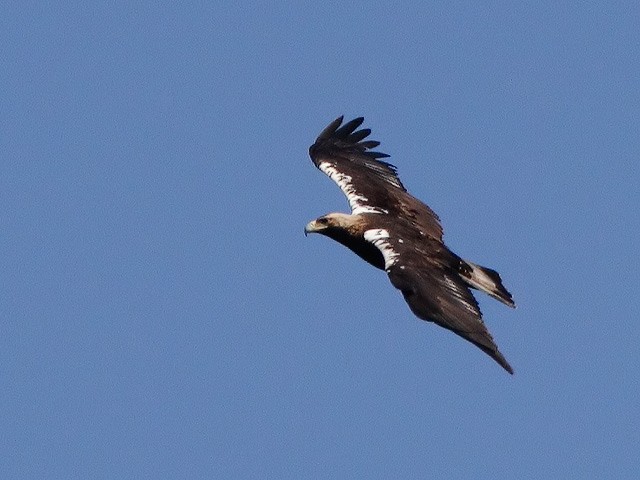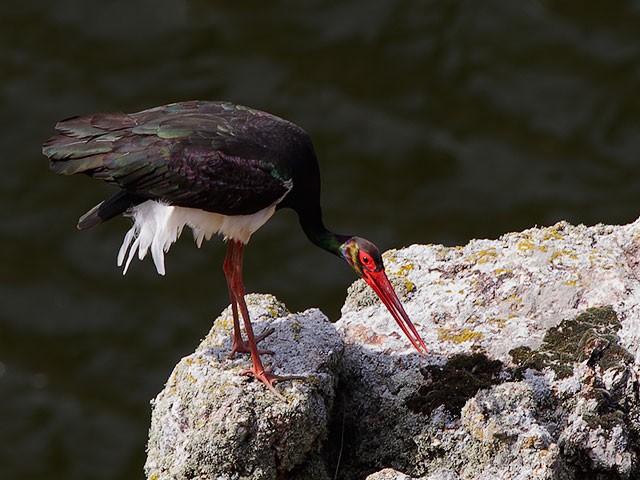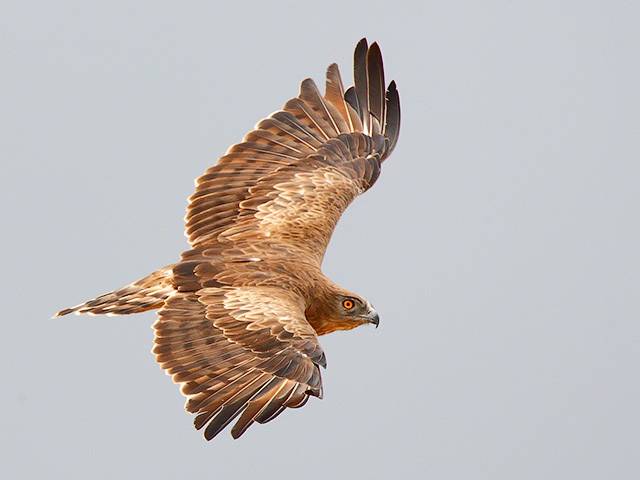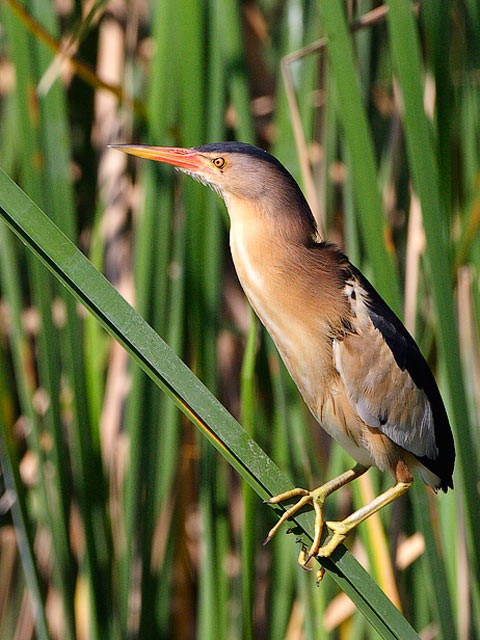There is still no sign of rain here, which has greatly affected the flowers: very small numbers are making for a bland scene instead of the normal swathes of rich colours covering the steppe like a Monet masterpiece. Life is not all doom and gloom, though, as the white Spanish Broom has been in flower for a few weeks, shortly followed by the deep yellow Mountain Broom; the multi-coloured fruit tree blossom is now beginning to die off but, along with the pink Tamarisk and plenty of White Heather, is still making the countryside very attractive. It has been a fairly strange March, with many normal spring migrants making no sort of appearance whatsoever, and the usual summer visitors also being quite late. The reason could well be the levanter winds: these are normally encountered further south on the coast around Andalucia, but this year have appeared much further north here in Extremadura, adding to the dryness of the area and causing mini dust-devils on the already arid ploughed fields. The winds probably mean that the migrants have been displaced and are following the coast on their perilous journeys north. The last few days of the month did see the arrival of many new species for this year, though, with Roller, Bee-eater, Spectacled Warbler, Nightingale, Black-eared Wheatear, Montagu's Harrier and Western Orphean Warbler all present on their breeding grounds. Butterflies are already in abundance, with Swallowtail, Green Hairstreak, Large Tortoiseshell, Spanish Festoon, Nettle Tree and many more that I cannot identify seen on most days.

Spanish Imperial Eagle, Spain (Steve Fletcher).
In Monfragüe, the well-watched Eagle Owl now has two chicks that will soon be out on the ledges entertaining the visitors with their head bobbing, looking for all the world like white balls of fluff with giant eyes. The Spanish Imperial Eagle pair gave great close views on a recent visit there, which is a little disconcerting as the female should now be sitting on eggs — but as long as she lays soon there should be no cause for concern. Perhaps because of the dry weather, there is a shortage of rabbits to feed the young. Within a few hundred yards of the Eagle Owl nest is another famous and well-watched site of a pair of Black Storks, locally named "Choni", but again, on my visit, none were on the nest; instead they were feeding along the river with Little, Cattle and Great White Egrets, and a few Grey Herons, all showing off their magnificent breeding plumage in the low setting sun. Red-rumped Swallows are still sparse, but watching one pair making repairs to last year's nest was a pleasant way to pass a few hours, while an Otter feeding in the river below proved a good distraction. I can think of far worse ways of spending my time! The Griffon Vultures are sitting on eggs; some have hatched already, the tiny heads sporting huge bills peeking out from under the parent's body. Quite a few pairs of Egyptian Vultures have arrived. They look tiny among the Griffon and Black Vultures circling round the many viewpoints, always on the lookout for food (which usually consists of dead sheep or cows) and always last in the pecking order when a carcass is found. Black Kites are now here in droves, with roosts of up to 50 birds to be found in Eucalyptus trees. They replace the Red Kites that have now mostly departed for northern climes, except for the small number of local breeders. The Bonelli's Eagles have been fairly quiet of late, but as they are early breeders there will only be half the number viewable as the females will be either sitting on eggs or brooding young, leaving the male to do all the work catching food. Alpine Swift numbers are still low too, although they do depart their nesting sites to feed a lot higher than the accompanying House Martins so are often difficult to locate except early and late in the day.

Black Stork, Spain (Steve Fletcher).
My drinking pool has been providing a lot of fun lately: it's nice to sit and watch common species such as Serin, Cirl Bunting and Spanish Sparrow drinking and bathing, each with their own method of approaching the pool to minimise possible predation. The Serins sit on the bank, fervently looking around before descending into the water, while the Hawfinch sits in the heights of a nearby tree for hours before coming down. Twenty-nine species visiting the pool in the last couple of weeks isn't too bad a total, with many more to come as soon as the rest of the migrants arrive. Sitting and watching their behaviour and interaction is fascinating, especially with the background noise of Cuckoos, Hoopoes, Ravens, Lesser Spotted Woodpeckers, and the extremely vocal Short-toed Eagle pair that nest nearby. A Nuthatch comes regularly to drink but lately has been gathering mud to make its nest-hole entrance smaller. It comes to the wet edge of the pool, gathers mud using its bill similarly to the way we would use chopsticks, then, when it has sufficient, it moves a foot or two to the drier area, rolls the mud into a neat ball then flies off to complete its building work.

Short-toed Eagle, Spain (Photo: Steve Fletcher)
On the steppe, the bustards are in full display mode: the Great Bustards fold their wings above their bodies showing the pure white underwings, head folded over the back, then waggle their wings in the "foam bath" display, guaranteed to make any female bustard swoon. The Little Bustard display is very different, the males resplendent in their posh restaurant waiters' outfits, complete with black waistcoat and bow tie; he attracts the females by doing a standing jump, as high as he can, blowing raspberries as he does so. Great Spotted Cuckoos seem to be in short supply this year, possibly due to the low numbers of Processional caterpillars available, which may be a product of the dry weather.
The wet areas are far more lively now, with Marsh Harriers carrying nest material, Little Bitterns calling noisily, Squacco Herons in their elegant breeding plumage, Purple Herons displaying over their nesting sites, and Savi's Warblers singing with their soft reeling. Penduline Tits seem to have been very easy to see this spring, many building their hanging nests in plain view. The first bird I saw when visiting was a nice Black-shouldered Kite hunting over the meadows, hovering then swooping down to pick up some hapless small mammal. The usual small flocks of migrating Garganey have been seen in many locations, usually accompanying Shovelers, Gadwall and Wigeon. Five Glossy Ibis feeding in a shallow pool quite oblivious to my presence was a nice find but, as usual, the sun was in the wrong direction for any photos able to bring out the glossy sheen for which they are named.

Little Bittern, Spain (Photo: Steve Fletcher)
The next couple of months will see many birders visiting here with tour companies, their shiny minibuses parked at the more popular spots, so if you haven't booked your space yet, now is the time to do it: treat yourself to that trip you have always wanted to do. And if you have been here before, well, you already know what you are missing by not visiting again. But, please, try to book with a company that uses local guides. You will definitely see more — local knowledge will always result in a far more successful trip — and you will be putting much-needed money into the local economy. Companies such as Honeyguide use local guides and donate a fair percentage of their income to local bird protection causes too, so are well worth signing up with. People can always contact me for details of companies who use local guides, or direct contact details of independent local guides and accommodation if required.
Finally for this month, two items of great news for Extremadura: firstly, the birth of three Iberian Lynx cubs (or kittens, if you prefer) at the captive breeding centre in Granadilla; secondly, the cancellation of a huge refinery building project. It has not been confirmed whether the lynx will be released or used for more breeding programmes and, although the shelving of the refinery will cost jobs and money for the government, it can only be good for the environment.

